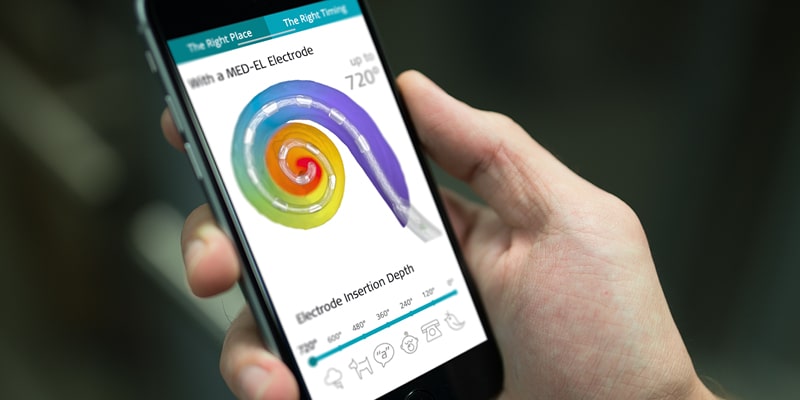MED-EL
Published Sep 21, 2022
Behind the Research on Reaching Closest to Natural Hearing

Advances in individualized cochlear implantation, as well as coding and fitting technology, have yielded increasing numbers of recipients who report excellent hearing outcomes, especially in complex listening environments.[18,19,20] But just how close to natural hearing is the sound from a cochlear implant using the latest technology? How is closest to natural hearing achieved, and what benefits can recipients enjoy when it is?
To answer these questions, we would like to share video clips from when we recently interviewed some of the world’s leading experts on these topics.
The first of these experts is Arizona State Prof. Michael Dorman. Dorman and his research team explored how cochlear implant recipients perceive sounds from their MED-EL cochlear implants and how close this is to natural hearing.[1]
The research team asked cochlear implant recipients who have single-sided deafness (i.e., an implanted deaf ear on one side and a normal hearing ear on the other side) to directly compare the sounds of their cochlear implant to sound approximations that were electronically generated. The sound approximations were played to their natural hearing ear until the recipients indicated that the sounds heard in the aided and unaided ears closely resembled each other.
How Cochlear Implant Electrode Array Insertion Depth Influences Voice Sound Quality
Watch as Prof. Dorman explains the logic behind his research methodology and plays the sound samples that most closely matched what MED-EL recipients hear from their cochlear implants. (Watch until 13:40.)
Can’t see the video? Watch it on YouTube.
The key takeaway here: The longer the electrode array, the more likely a patient will experience a voice quality in the range of normal.
Dorman et al. found that insertion depth, and thus electrode array length, are key factors that influence how likely a patient is to perceive voice quality that sounds normal. According to their findings, when the most apical electrode contact is nearest to tissue around 390 Hz, no shift in formant frequencies is needed to make the sounds match. But when the most apical electrode to stimulate the tissue nearest to electrode contact is around 720 Hz (with about 4 mm less insertion depth), a shift of around +160 Hz is needed to make the sounds match, albeit with lower voice quality.
Cochlear Implants as a Treatment for Single-Sided Deafness Patients
Through his work with patients with single-sided deafness, Prof. Dorman and his research team also investigated how patients with single-sided deafness perceive the world and how effective cochlear implants are as a treatment for SSD.[2] Watch until 17:24 to find out what he has learned so far.
Can’t see the video? Watch it on YouTube.
Key takeaway here: The world often sounds “distant and tinny” through only one ear. But “the soundstage is broad”, and it sounds like what you remember with one normal hearing ear and one cochlear implant. A large amount of data suggest that music can even sound better when you add an implant to a normal hearing ear.
Deep Insertion & Acoustic Capabilities of Cochlear Implant Recipients
Recipients can gain more than better sound quality from stimulating the second turn of the cochlea. According to Prof. Paul Van de Heyning, a large amount of research now exists on the impact of stimulating the cochlea’s second turn on the acoustic capabilities of patients.[6,7,8] With the current electrodes available on the market, only the FLEX 28 and FLEXSOFT arrays can stimulate the entire range of the cochlea, and according to Van de Heyning’s research, it yields better speech recognition in noise in daily life and these patients tend to see positive outcomes sooner after the first fitting. Watch until 22:55.
Can’t see the video? Watch it on YouTube.
A key takeaway from Prof. Van de Heyning: “Nature has provided us with a second turn of the cochlea and an apex to perceive low tones.” Thus, stimulating the second turn helps us perceive low tones, rhythms, intonation, knowing if a sentence ends as a statement or a question, or even recognize if a voice is from a male or female speaker.
How Angular Insertion Depth Affects Speech in Noise Perception and Music Quality
Van de Heyning noted that since 25% of the spiral ganglion neurons are located in the second turn of the cochlea and extend beyond the basal turn,[3,4,5] clear low frequency perception can only be achieved with a place-dependent stimulation rate and electrodes placed well into the second turn of the cochlea.[3,13,14,15] If the second turn is stimulated, perception of both speech in noise and music quality improve.[12] Watch (until 41:19) as Van de Heyning discusses optimal angular insertion depth in detail:
Can’t see the video? Watch it on YouTube.
Key takeaway: Covering the entire range of the cochlea including the second turn allows a recipient to achieve the closest to natural hearing.
Individualizing Electrode Length
Since human cochleae can vary in size up to 50%, CI electrode arrays are not one-size-fit-all. Matching electrodes to cochlear frequency maps is required for the “optimal fitting and performance of CI recipients.” [3,14,16,17] Watch (until 42:51) as Van de Heyning discusses assessing the size of the cochlea to select the optimal length electrode array for an individual cochlea:
Can’t see the video? Watch it on YouTube.
Key takeaway: Van de Heyning advocates strongly for assessing the size of the cochlea to calculate how long the electrode should be for an individual recipient to reach 650 degrees angular insertion depth. One such tool Van de Heyning recommends for doing so, along with temporal CT scans, is OTOPLAN.
Music & Outcomes with the Closest to Natural Hearing
What is the outcome for recipients when cochlear implantation is done to achieve the closest to natural hearing? Roy Smith, who experienced gradual bilateral hearing loss for about 35 years starting around the age of 30, received sequential bilateral cochlear implants. Watch (until 49:53) as Roy describes his experiences being a musician with deafness, hearing aids, and cochlear implants:
Can’t see the video? Watch it on YouTube.
After his implantations, Roy was able to perform in ways not possible when he had his hearing aids. To find out what he gained and what limitations he still experiences, watch (until 51:27) as Roy describes these in detail:
Can’t see the video? Watch it on YouTube.
More on Music and Closest to Natural Hearing
For more from the experts on the closest to natural hearing and music perception, check out our Music Special Session of ExpertsONLINE: Sound and Music Perception With Cochlear Implants. MED-EL’s signal processing expert Peter Nopp and professors Paul Van De Heyning, Meg Dillon, and Michael Dorman discussed pitch matching, cochlea coverage, coding strategies, and how to achieve closest to natural hearing on October 6, 2022.
Can’t see the video? Watch it on YouTube.
This was part of the upcoming Sound Sensation music festival hosted by MED-EL celebrating the musical talents of hearing implant users. To view the videos, go to: https://hearlife.medel.com/campaigns/sound-sensation/
Subscribe for More Research Updates from MED-EL
Don’t miss more articles like this one. Subscribe to the MED-EL Professionals Blog now.
References
- Dorman, M., Natale, S., Baxter, L., Zeitler, D., Carlson, M., & Lorens, A. et al. (2020). Approximations to the Voice of a Cochlear Implant: Explorations With Single-Sided Deaf Listeners. Trends In Hearing, 24, 233121652092007. https://doi.org/10.1177/2331216520920079
- Zeitler, D., Sladen, D., DeJong, M., Torres, J., Dorman, M., & Carlson, M. (2019). Cochlear implantation for single-sided deafness in children and adolescents. International Journal Of Pediatric Otorhinolaryngology, 118, 128-133. https://doi.org/10.1016/j.ijporl.2018.12.037
- Li, H., Schart-Morén, N., Rohani, S., Ladak, H., Rask-Andersen, H., & Agrawal, S. (2020). Synchrotron Radiation-Based Reconstruction of the Human Spiral Ganglion: Implications for Cochlear Implantation. Ear & Hearing, 41(1), 173-181. https://doi.org/10.1097/aud.0000000000000738
- Dhanasingh, A., Rajan, G., & van de Heyning, P. (2020). Presence of the spiral ganglion cell bodies beyond the basal turn of the human cochlea. Cochlear Implants International, 21(3), 145-152. https://doi.org/10.1080/14670100.2019.1694226
- Dhanasingh, A., Jolly, C., Rajan, G., & van de Heyning, P. (2020). Literature Review on the Distribution of Spiral Ganglion Cell Bodies inside the Human Cochlear Central Modiolar Trunk. The Journal Of International Advanced Otology, 16(1), 104-110. https://doi.org/10.5152/iao.2020.7510
- Heyning, Paul van de, Arauz, S., Atlas, M., Baumgartner, W., Caversaccio, M., & Chester-Browne, R. et al. (2016). Electrically evoked compound action potentials are different depending on the site of cochlear stimulation. Cochlear Implants International, 17(6), 251-262. https://doi.org/10.1080/14670100.2016.1240427
- Kleine Punte, A., De Bodt, M., & Van de Heyning, P. (2014). Long-Term Improvement of Speech Perception with the Fine Structure Processing Coding Strategy in Cochlear Implants. ORL, 76(1), 36-43. https://doi.org/10.1159/000360479
- Vermeire, K., Kleine Punte, A., & Van de Heyning, P. (2010). Better Speech Recognition in Noise with the Fine Structure Processing Coding Strategy. ORL, 72(6), 305-311. https://doi.org/10.1159/000319748
- Canfarotta, M., Dillon, M., Buchman, C., Buss, E., O’Connell, B., & Rooth, M. et al. (2020). Long‐Term Influence of Electrode Array Length on Speech Recognition in Cochlear Implant Users. The Laryngoscope, 131(4), 892-897. https://doi.org/10.1002/lary.28949
- Buchman, C., Dillon, M., King, E., Adunka, M., Adunka, O., & Pillsbury, H. (2014). Influence of Cochlear Implant Insertion Depth on Performance. Otology &; Neurotology, 35(10), 1773-1779. https://doi.org/10.1097/mao.0000000000000541
- O’Connell, B., Hunter, J., Gifford, R., Rivas, A., Haynes, D., Noble, J., & Wanna, G. (2016). Electrode Location and Audiologic Performance After Cochlear Implantation. Otology & Neurotology, 37(8), 1032-1035. https://doi.org/10.1097/mao.0000000000001140
- Roy, A., Penninger, R., Pearl, M., Wuerfel, W., Jiradejvong, P., & Carver, C. et al. (2016). Deeper Cochlear Implant Electrode Insertion Angle Improves Detection of Musical Sound Quality Deterioration Related to Bass Frequency Removal. Otology &Amp; Neurotology, 37(2), 146-151. https://doi.org/10.1097/mao.0000000000000932
- Schatzer, R., Vermeire, K., Visser, D., Krenmayr, A., Kals, M., & Voormolen, M. et al. (2014). Electric-acoustic pitch comparisons in single-sided-deaf cochlear implant users: Frequency-place functions and rate pitch. Hearing Research, 309, 26-35. https://doi.org/10.1016/j.heares.2013.11.003
- Rader, T., Döge, J., Adel, Y., Weissgerber, T., & Baumann, U. (2016). Place dependent stimulation rates improve pitch perception in cochlear implantees with single-sided deafness. Hearing Research, 339, 94-103. https://doi.org/10.1016/j.heares.2016.06.013
- Landsberger, D., Vermeire, K., Claes, A., Van Rompaey, V., & Van de Heyning, P. (2016). Qualities of Single Electrode Stimulation as a Function of Rate and Place of Stimulation with a Cochlear Implant. Ear & Hearing, 37(3), e149-e159. https://doi.org/10.1097/aud.0000000000000250
- Jiam, N., Pearl, M., Carver, C., & Limb, C. (2016). Flat-Panel CT Imaging for Individualized Pitch Mapping in Cochlear Implant Users. Otology &Amp; Neurotology, 37(6), 672-679. https://doi.org/10.1097/mao.0000000000001060
- Jiam, N., Gilbert, M., Cooke, D., Jiradejvong, P., Barrett, K., Caldwell, M., & Limb, C. (2018). Association Between Flat-Panel Computed Tomographic Imaging–Guided Place-Pitch Mapping and Speech and Pitch Perception in Cochlear Implant Users. JAMA Otolaryngology–Head &Amp; Neck Surgery, 145(2), 109. https://doi.org/10.1001/jamaoto.2018.3096
- Buss, E., Dillon, M.T., Rooth, M.A., King, E.R., Deres, E.J., Buchman, C.A., Pillsbury, H.C., & Brown, K.D. (2018). Effect of cochlear implantation on binaural hearing in adults with unilateral hearing loss. Trends Hear. 22.
- Killan, C., Scally, A., Killan, E., Totten, C., & Raine, C. (2018). Factors affecting sound-source localization in children with simultaneous or sequential bilateral cochlear implants. Ear & Hearing, 40(4), 870–877.
- Survey of MED-EL cochlear implant recipients. 2019. Data on file.
MED-EL
Was this article helpful?
Thanks for your feedback.
Sign up for newsletter below for more.
Thanks for your feedback.
Please leave your message below.
CTA Form Success Message
Send us a message
Field is required
John Doe
Field is required
name@mail.com
Field is required
What do you think?
The content on this website is for general informational purposes only and should not be taken as medical advice. Please contact your doctor or hearing specialist to learn what type of hearing solution is suitable for your specific needs. Not all products, features, or indications shown are approved in all countries.
MED-EL



